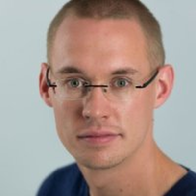Taylor-Couette turbulence
Promotion date: September 19.
Promotor: Prof.dr.rer.nat. Detlef Lohse
Assistant Promotor: Prof.dr. Chao Sun
| The difficulty in describing turbulence resides in the fact that turbulent flows are generally irregular, chaotic, and therefore hard to predict. The Taylor-Couette apparatus is one of the fundamental configurations to test theories in fluid dynamics. Fluid is confined between two independently rotating concentric cylinders. This simple closed geometry has many symmetries, allowing a well-controlled environment to perform shear experiments. The apparatus has been used to measure the viscosity of a fluid, to study hydrodynamic instabilities, pattern formation, and turbulence. Local and global measurements are performed in order to strengthen the knowledge of the Taylor-Couette flow geometry. The system was found to have maximum transport when the cylinders are in a counter rotation a=-ω0/ωi=0,4. Kolmogorov’s paradigm was being questioned. Evidence was found of multiple turbulent states for very large Reynolds numbers (Re=106). Local velocity profiles were presented over a wide range of “a”. Laser anemometry measurements were performed in the center of the gap of the Taylor-Couette apparatus. In the last chapter it is shown how the curvature of the outer cylinder affects the focal position and a velocity measurement using laser Doppler measurement. It is shown that the velocity profiles are significantly improved. |
Your research was fundamental in nature.
Yes, it was. The Taylor-Couette apparatus of our group, the Physics of Fluids group, is unique as very high Reynolds numbers of turbulence can be studied using this apparatus. The apparatus has a height of roughly one meter; the concentric cylinders may rotate up to 90 kilometers per hour. Cooling the apparatus while functioning, is very important as the temperature of the containing fluid (water) may rise up to one Kelvin every minute. Balancing of the axes is of prime importance as well, as without balancing the apparatus would vibrate very intensely and possibly fly apart. At the moment we are about to finish a smaller boiling Taylor-Couette apparatus which is almost operational at this very time. The hope is to design new experiments in which special fluids are brought towards their boiling temperatures.
Because of the extreme conditions experiments can be performed which can be characterized as ‘the ultimate regime’: having a turbulent bulk and a turbulent boundary layer, approaching reality conditions very closely. In this thesis three kinds of experiments could be distinguished: experiments to measure the energy being dissipated by the fluid between the concentric walls; particle image velocity measurements to show details of turbulence, azimuthally and radially, in which photographic images are shot to capture the trajectory of tiny tracer particles which are added to the flow; and, finally, correction measurements to account for the curvature conditions of the apparatus.
Do you recall some special moments during your PhD period?
It was a nice result to be able to falsify the Kolmogorov prediction in which he states that at very high Reynolds numbers, no structures could possibly be found under heavy turbulent conditions. Instead, we were able to find structures and characterize them. We found that the structures were even dependent on the trajectory via which the end situation was reached. This presence of structures and the hysteresis effect, were published in Nature Communications.
In what magazines were you able to publish your results?
The first three chapters of my thesis were each published in Physical Review Letters. One article in Nature Communications, one article in Physical Review E and two articles in Journal of Fluid Mechanics were published as well. The European Journal of Mechanics – B/Fluids published the technical aspects concerning some experimental aspects which I explained.
In what way did you improve as a researcher during your PhD period?
Especially on writing publications I made serious progress as I never wrote one before. In the first publication Professor Detlef Lohse did the main writing, starting from the experimental results I obtained. After this first publication - and reading several other publications myself - I found my way to publishing my results in a summarily and scientific way. This I believe in: when one is able to present the results concisely, the scientific story is easier to tell from there, such as in poster sessions or at conferences.
The collaboration with my supervisor Professor Detlef Lohse was very inspirational. We had written down a list of subjects and issues to look into on his whiteboard at the beginning of my PhD project. We were happy to be able to cross out most of them.
What are your future plans?
I would like to stay in academics, as I am especially interested in theoretical scientific questions and to find ways to answer and verify or falsify them. The coming year I will be working as a post-doc at the École Normale Supérieure de Lyon. The contract will last one year. I hope my Rubicon project proposal will be granted by then, allowing me to stay for two more years. One day I hope to become a leader of my own research group, be it in Twente or elsewhere in the world.

